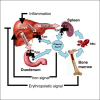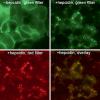The role of hepcidin in iron metabolism
- PMID: 19907144
- PMCID: PMC2855274
- DOI: 10.1159/000243791
The role of hepcidin in iron metabolism
Abstract
Hepcidin is the central regulator of systemic iron homeostasis. Dysregulation of hepcidin production results in a variety of iron disorders. Hepcidin deficiency is the cause of iron overload in hereditary hemochromatosis, iron-loading anemias, and hepatitis C. Hepcidin excess is associated with anemia of inflammation, chronic kidney disease and iron-refractory iron deficiency anemia. Diagnostic and therapeutic applications of this new knowledge are beginning to emerge. Dr. Ernest Beutler played a significant role in advancing our understanding of the function of hepcidin. This review is dedicated to his memory.
Copyright 2009 S. Karger AG, Basel.
Figures




Similar articles
-
Molecular mechanisms regulating hepcidin revealed by hepcidin disorders.ScientificWorldJournal. 2011 Jul 7;11:1357-66. doi: 10.1100/tsw.2011.130. ScientificWorldJournal. 2011. PMID: 21789471 Free PMC article. Review.
-
Hepcidin, a key regulator of iron metabolism and mediator of anemia of inflammation.Blood. 2003 Aug 1;102(3):783-8. doi: 10.1182/blood-2003-03-0672. Epub 2003 Mar 27. Blood. 2003. PMID: 12663437 Review.
-
Regulation of hepcidin and iron-overload disease.Annu Rev Pathol. 2009;4:489-515. doi: 10.1146/annurev.pathol.4.110807.092205. Annu Rev Pathol. 2009. PMID: 19400694 Review.
-
Hepcidin biology and therapeutic applications.Expert Rev Hematol. 2010 Apr;3(2):153-5. doi: 10.1586/ehm.10.1. Expert Rev Hematol. 2010. PMID: 21083458
-
Regulation of iron metabolism by hepcidin.Annu Rev Nutr. 2006;26:323-42. doi: 10.1146/annurev.nutr.26.061505.111303. Annu Rev Nutr. 2006. PMID: 16848710 Review.
Cited by
-
Regulation of erythropoiesis by hypoxia-inducible factors.Blood Rev. 2013 Jan;27(1):41-53. doi: 10.1016/j.blre.2012.12.003. Epub 2013 Jan 3. Blood Rev. 2013. PMID: 23291219 Free PMC article. Review.
-
The metabogenic role of iron in chronic chagasic cardiac failure.Mem Inst Oswaldo Cruz. 2015 Feb;110(1):154-5. doi: 10.1590/0074-02760140461. Epub 2015 Feb 3. Mem Inst Oswaldo Cruz. 2015. PMID: 25742279 Free PMC article. No abstract available.
-
Iron deficiency and heart failure: diagnostic dilemmas and therapeutic perspectives.Eur Heart J. 2013 Mar;34(11):816-29. doi: 10.1093/eurheartj/ehs224. Epub 2012 Oct 25. Eur Heart J. 2013. PMID: 23100285 Free PMC article. Review.
-
Iron homeostasis: a new job for macrophages in adipose tissue?Trends Endocrinol Metab. 2015 Feb;26(2):101-9. doi: 10.1016/j.tem.2014.12.005. Epub 2015 Jan 16. Trends Endocrinol Metab. 2015. PMID: 25600948 Free PMC article. Review.
-
Iron Deficiency in Patients with Advanced Heart Failure.Medicina (Kaunas). 2022 Oct 31;58(11):1569. doi: 10.3390/medicina58111569. Medicina (Kaunas). 2022. PMID: 36363528 Free PMC article.
References
-
- Peslova G, Petrak J, Kuzelova K, Hrdy I, Halada P, Kuchel PW, Soe-Lin S, Ponka P, Sutak R, Becker E, Huang ML, Suryo RY, Richardson DR, Vyoral D. Hepcidin, the hormone of iron metabolism, is bound specifically to alpha-2-macroglobulin in blood. Blood. 2009;113:6225–6236. - PubMed
-
- Ganz T, Olbina G, Girelli D, Nemeth E, Westerman M. Immunoassay for human serum hepcidin. Blood. 2008;112:4292–4297. - PubMed
Publication types
MeSH terms
Substances
Grants and funding
LinkOut - more resources
Full Text Sources
Other Literature Sources
Medical

